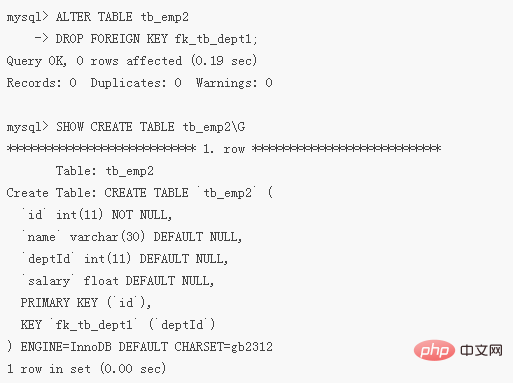What is the use of mysql foreign keys?
mysql foreign key is mainly used to establish the relationship between the master table and the slave table, establish a connection for the data of the two tables, and constrain the consistency and integrity of the data in the two tables; its role is to keep the data consistent The main purpose is to control the data stored in foreign key tables. A table can have one or more foreign keys, and the foreign key can be null. If it is not null, the value of each foreign key must be equal to a certain value of the primary key in the main table.

The operating environment of this tutorial: windows7 system, mysql8 version, Dell G3 computer.
MySQL foreign key constraint (FOREIGN KEY) is a special field of the table, often used together with primary key constraints. For two tables with an associated relationship, the table where the primary key in the associated field is located is the primary table (parent table), and the table where the foreign key is located is the secondary table (child table).
The role of MySQL foreign keys:
Maintain data consistency and integrity. The main purpose is to control the data stored in the foreign key table. To associate two tables, foreign keys can only reference the values of columns in the table!
Foreign keys are used to establish the association between the master table and the slave table, establish a connection for the data in the two tables, and constrain the consistency and integrity of the data in the two tables. For example, a fruit stall only has four kinds of fruits: apples, peaches, plums, and watermelons. Then, when you come to the fruit stall to buy fruits, you can only choose apples, peaches, plums, and watermelons. Other fruits are not available for purchase.
When a record is deleted from the main table, the corresponding record from the table must also be changed accordingly. A table can have one or more foreign keys, and the foreign key can be null. If it is not null, the value of each foreign key must be equal to a certain value of the primary key in the main table.
When defining foreign keys, you need to comply with the following rules:
The main table must already exist in the database, or be the table currently being created. If it is the latter case, the master table and the slave table are the same table. Such a table is called a self-referential table, and this structure is called self-referential integrity.
A primary key must be defined for the main table.
The primary key cannot contain null values, but null values are allowed in foreign keys. That is, as long as every non-null value of the foreign key appears in the specified primary key, the contents of the foreign key are correct.
Specify the column name or a combination of column names after the table name of the main table. This column or combination of columns must be the primary key or candidate key of the primary table.
The number of columns in the foreign key must be the same as the number of columns in the primary key of the main table.
The data type of the column in the foreign key must be the same as the data type of the corresponding column in the primary key of the main table.
Add foreign key constraints when modifying the table
The prerequisite for adding foreign key constraints is: from the foreign key in the table The data in the column must be consistent with the data in the primary key column in the main table or there is no data.
The syntax format for adding foreign key constraints when modifying the data table is as follows:
ALTER TABLE <数据表名> ADD CONSTRAINT <外键名> FOREIGN KEY(<列名>) REFERENCES <主表名> (<列名>);
Example: Modify the data table tb_emp2, set the field deptId as a foreign key, and match the data Association with the primary key id of table tb_dept1
ALTER TABLE tb_emp2 ADD CONSTRAINT fk_tb_dept1 FOREIGN KEY(deptId)REFERENCES tb_dept1(id);

Delete foreign key constraint
When a table does not When a foreign key constraint is required, it needs to be removed from the table. Once the foreign key is deleted, the association between the master table and the slave table will be released.
The syntax format for deleting foreign key constraints is as follows:
ALTER TABLE <表名> DROP FOREIGN KEY <外键约束名>;
Example: Delete the foreign key constraint fk_tb_dept1 in the data table tb_emp2
ALTER TABLE tb_emp2 DROP FOREIGN KEY fk_tb_dept1;

[Related recommendations: mysql video tutorial]
The above is the detailed content of What is the use of mysql foreign keys?. For more information, please follow other related articles on the PHP Chinese website!

Hot AI Tools

Undresser.AI Undress
AI-powered app for creating realistic nude photos

AI Clothes Remover
Online AI tool for removing clothes from photos.

Undress AI Tool
Undress images for free

Clothoff.io
AI clothes remover

Video Face Swap
Swap faces in any video effortlessly with our completely free AI face swap tool!

Hot Article

Hot Tools

Notepad++7.3.1
Easy-to-use and free code editor

SublimeText3 Chinese version
Chinese version, very easy to use

Zend Studio 13.0.1
Powerful PHP integrated development environment

Dreamweaver CS6
Visual web development tools

SublimeText3 Mac version
God-level code editing software (SublimeText3)

Hot Topics
 1386
1386
 52
52
 MySQL: Simple Concepts for Easy Learning
Apr 10, 2025 am 09:29 AM
MySQL: Simple Concepts for Easy Learning
Apr 10, 2025 am 09:29 AM
MySQL is an open source relational database management system. 1) Create database and tables: Use the CREATEDATABASE and CREATETABLE commands. 2) Basic operations: INSERT, UPDATE, DELETE and SELECT. 3) Advanced operations: JOIN, subquery and transaction processing. 4) Debugging skills: Check syntax, data type and permissions. 5) Optimization suggestions: Use indexes, avoid SELECT* and use transactions.
 How to open phpmyadmin
Apr 10, 2025 pm 10:51 PM
How to open phpmyadmin
Apr 10, 2025 pm 10:51 PM
You can open phpMyAdmin through the following steps: 1. Log in to the website control panel; 2. Find and click the phpMyAdmin icon; 3. Enter MySQL credentials; 4. Click "Login".
 MySQL: An Introduction to the World's Most Popular Database
Apr 12, 2025 am 12:18 AM
MySQL: An Introduction to the World's Most Popular Database
Apr 12, 2025 am 12:18 AM
MySQL is an open source relational database management system, mainly used to store and retrieve data quickly and reliably. Its working principle includes client requests, query resolution, execution of queries and return results. Examples of usage include creating tables, inserting and querying data, and advanced features such as JOIN operations. Common errors involve SQL syntax, data types, and permissions, and optimization suggestions include the use of indexes, optimized queries, and partitioning of tables.
 How to use single threaded redis
Apr 10, 2025 pm 07:12 PM
How to use single threaded redis
Apr 10, 2025 pm 07:12 PM
Redis uses a single threaded architecture to provide high performance, simplicity, and consistency. It utilizes I/O multiplexing, event loops, non-blocking I/O, and shared memory to improve concurrency, but with limitations of concurrency limitations, single point of failure, and unsuitable for write-intensive workloads.
 Why Use MySQL? Benefits and Advantages
Apr 12, 2025 am 12:17 AM
Why Use MySQL? Benefits and Advantages
Apr 12, 2025 am 12:17 AM
MySQL is chosen for its performance, reliability, ease of use, and community support. 1.MySQL provides efficient data storage and retrieval functions, supporting multiple data types and advanced query operations. 2. Adopt client-server architecture and multiple storage engines to support transaction and query optimization. 3. Easy to use, supports a variety of operating systems and programming languages. 4. Have strong community support and provide rich resources and solutions.
 MySQL's Place: Databases and Programming
Apr 13, 2025 am 12:18 AM
MySQL's Place: Databases and Programming
Apr 13, 2025 am 12:18 AM
MySQL's position in databases and programming is very important. It is an open source relational database management system that is widely used in various application scenarios. 1) MySQL provides efficient data storage, organization and retrieval functions, supporting Web, mobile and enterprise-level systems. 2) It uses a client-server architecture, supports multiple storage engines and index optimization. 3) Basic usages include creating tables and inserting data, and advanced usages involve multi-table JOINs and complex queries. 4) Frequently asked questions such as SQL syntax errors and performance issues can be debugged through the EXPLAIN command and slow query log. 5) Performance optimization methods include rational use of indexes, optimized query and use of caches. Best practices include using transactions and PreparedStatemen
 MySQL and SQL: Essential Skills for Developers
Apr 10, 2025 am 09:30 AM
MySQL and SQL: Essential Skills for Developers
Apr 10, 2025 am 09:30 AM
MySQL and SQL are essential skills for developers. 1.MySQL is an open source relational database management system, and SQL is the standard language used to manage and operate databases. 2.MySQL supports multiple storage engines through efficient data storage and retrieval functions, and SQL completes complex data operations through simple statements. 3. Examples of usage include basic queries and advanced queries, such as filtering and sorting by condition. 4. Common errors include syntax errors and performance issues, which can be optimized by checking SQL statements and using EXPLAIN commands. 5. Performance optimization techniques include using indexes, avoiding full table scanning, optimizing JOIN operations and improving code readability.
 Monitor Redis Droplet with Redis Exporter Service
Apr 10, 2025 pm 01:36 PM
Monitor Redis Droplet with Redis Exporter Service
Apr 10, 2025 pm 01:36 PM
Effective monitoring of Redis databases is critical to maintaining optimal performance, identifying potential bottlenecks, and ensuring overall system reliability. Redis Exporter Service is a powerful utility designed to monitor Redis databases using Prometheus. This tutorial will guide you through the complete setup and configuration of Redis Exporter Service, ensuring you seamlessly build monitoring solutions. By studying this tutorial, you will achieve fully operational monitoring settings




